Establishing a strong foundation of customer trust is crucial for any business looking to expand its customer base. In today’s competitive market, winning over new customers requires more than just a great product or service; it demands a strategic approach to building credibility.

Effective customer trust strategies can make all the difference in converting potential clients into loyal customers. By implementing the right trust-building techniques, businesses can foster a loyal customer base and drive long-term growth.
Table of Contents
What role do reviews play in building trust?
Reviews play a crucial role in building trust because they provide real, unbiased feedback from other customers. Positive reviews reassure potential buyers about the quality and reliability of a product or service, while even constructive criticism shows transparency and honesty. This social proof helps new customers feel more confident in their decision to engage with a business.
The foundation of any successful business is built on trust, and understanding the psychological aspects that drive customer trust is essential. Trust is not just a feeling; it’s a psychological state that is influenced by various factors, including past experiences, perceived reliability, and the quality of interactions.
How can rewards influence first impressions?
Rewards can significantly shape first impressions by creating a positive association with a person, brand, or experience. When someone receives a reward—whether it’s a compliment, discount, or small gift—they are more likely to view the giver favorably. This positive reinforcement fosters trust and likability, making the initial interaction more memorable and encouraging continued engagement.
Are you struggling to instantly earn the trust of new customers and turn them into loyal advocates?
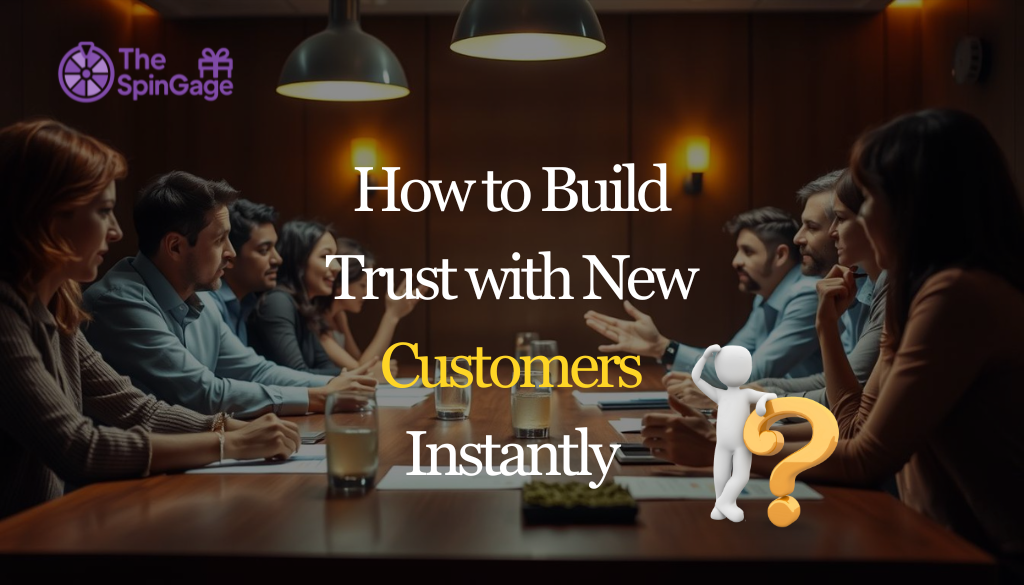
Building trust isn’t just about offering a great product or service—it’s about creating a lasting connection through every interaction. From the very first impression on your website to follow-up communications, every detail matters: professional branding, transparent policies, clear messaging, and personalized experiences all work together to create credibility.
When you showcase social proof like customer testimonials, demonstrate expertise in an approachable way, and address concerns proactively, you not only reassure potential clients but also foster loyalty that lasts.
How does SpinGage help businesses appear trustworthy?

SpinGage helps businesses appear trustworthy by providing clear, transparent, and professional customer engagement tools. By showcasing credibility through verified reviews, detailed product insights, and reliable support, SpinGage builds confidence with potential clients, making them more likely to trust and choose a business.
Leveraging technology for security, transparency, and convenience further enhances customer confidence, while consistent experiences across all touchpoints reinforce your brand’s reliability. By integrating these strategies, your business can transform new visitors into devoted customers who advocate for your brand, driving long-term growth and success.
How does SpinGage automate review collection?
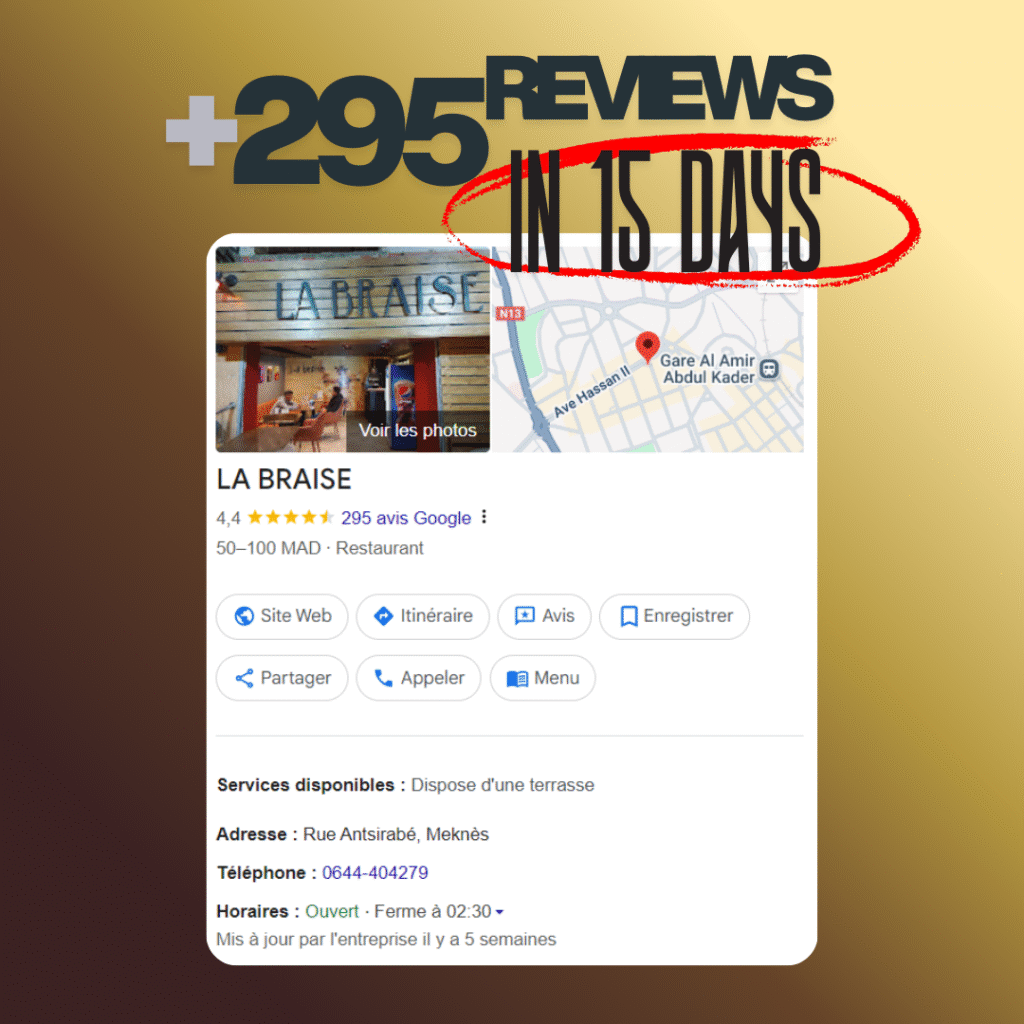
+295 REVIEWS IN JUST 15 DAYS :
Labraise is a restaurant that gained more than 295 new customer reviews and increased their income by using TheSpinGage solution.
They placed a flyer with a QR code on every table, allowing each diner to scan and spin the wheel. Labraise used a 100% winning ratio plan, where customers always won either 10% off their meal or a free soda.
This simple gamification encouraged guests to leave reviews, boosted loyalty, and kept customers coming back.

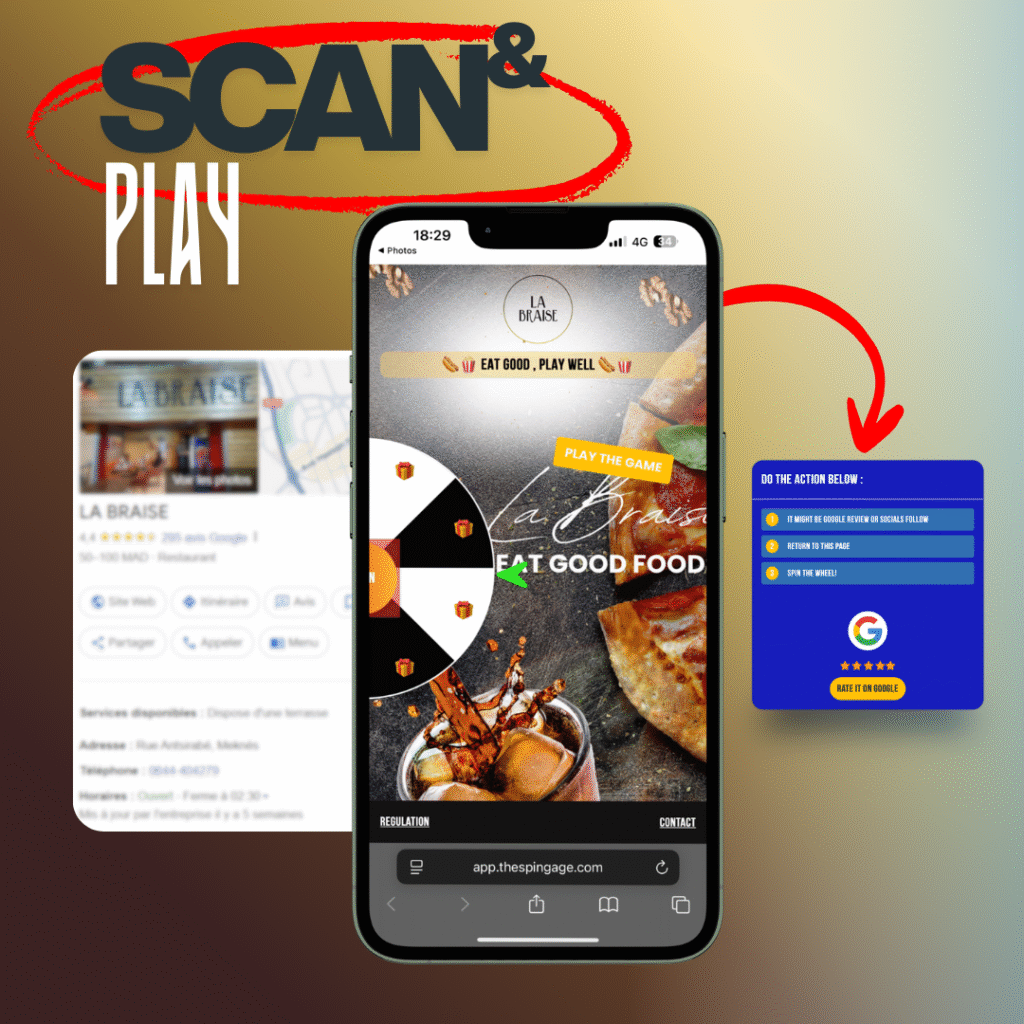

HOW IT WORKS IN 4 EASY STEPS ?
1 – Scan the QR Code
Clients simply scan the QR code placed on the table or provided directly by you.
2- Take Action First
To unlock the gameplay, they must complete the required action.
3- Spin the Wheel
Once unlocked, they spin the wheel to test their luck.
4- Win Rewards
If they win, a QR code is instantly sent to their email. If not, nothing happens. In both cases, the game is locked for 24 hours, ensuring fairness and excitement for the next try.
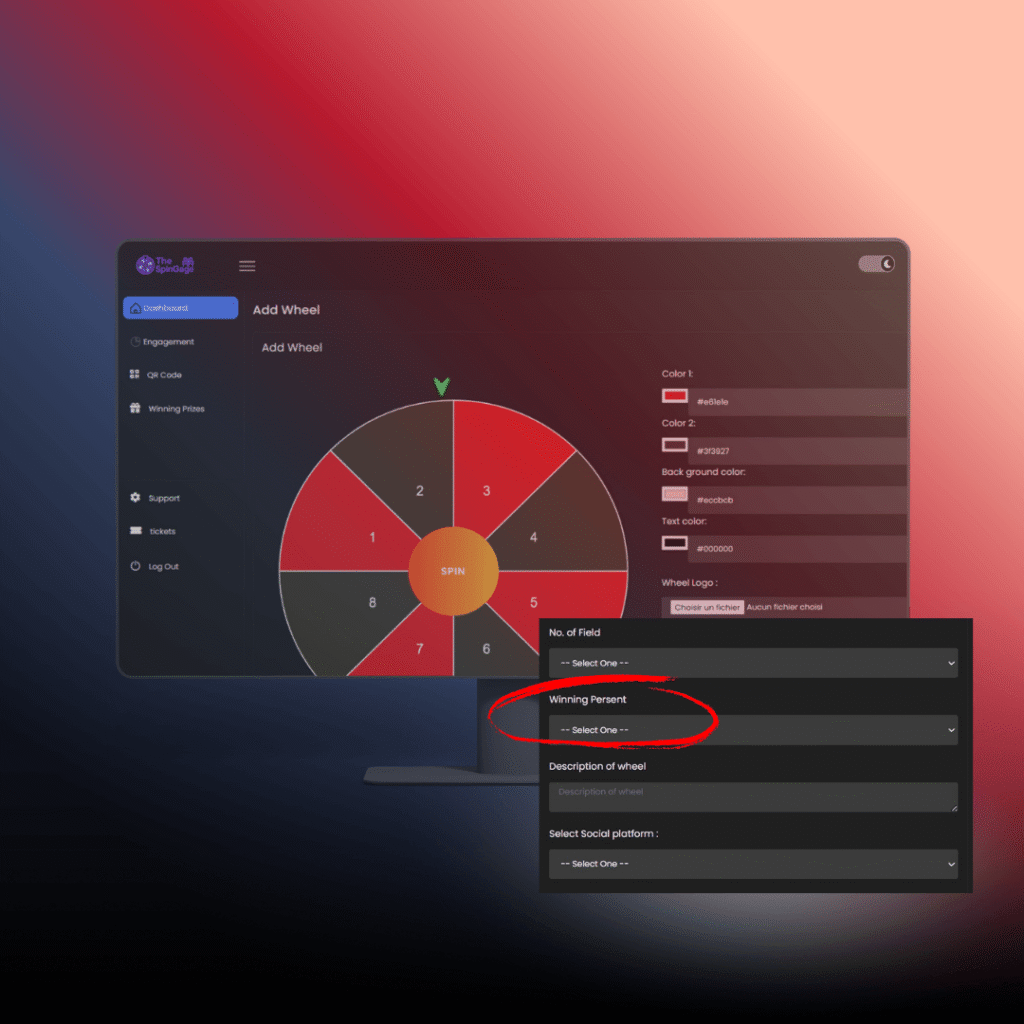
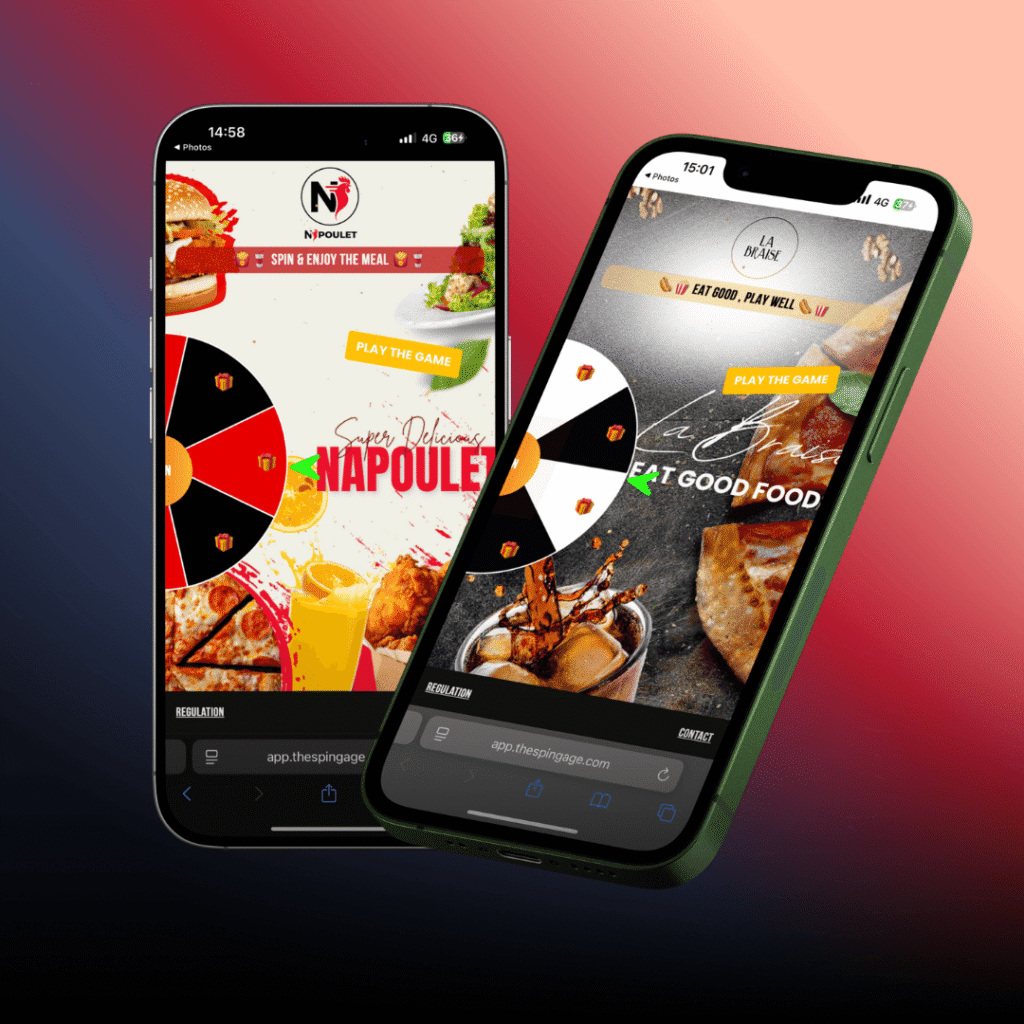

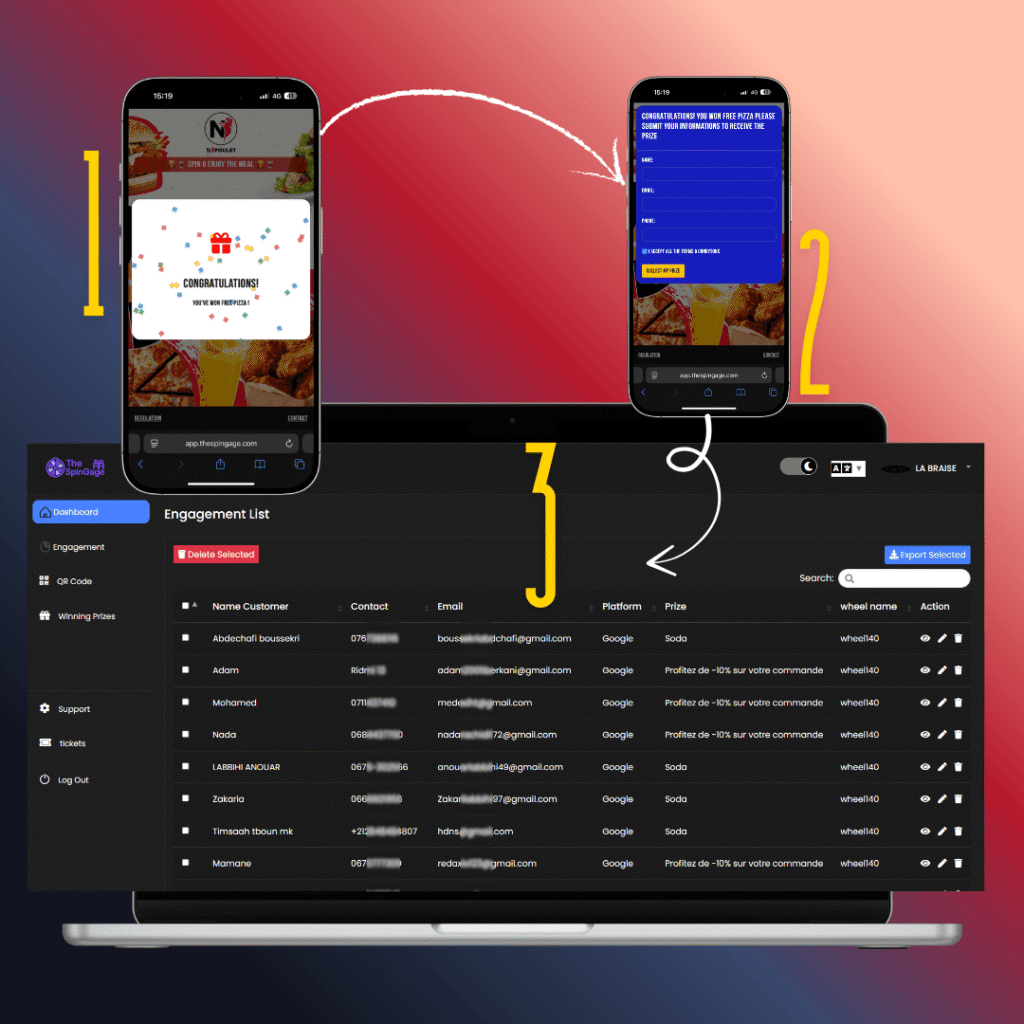
🛠️ Flexible Tracking Options
Track platform Top performing .
Track the wheel segments (number of prizes, Winner Gameplay).
Number of Plays , Track top performing wheel
Set up expiration dates for vouchers and offers.
Get Acces to LEADS , Extraxt & Modiify it .
Why You Should Opt for TheSpinGage Solution
Running a business today is not just about serving customers – it’s about creating memorable experiences that keep them coming back and spreading the word. That’s exactly what TheSpinGage delivers.
🎯 Stand Out from Your Competitors
Most restaurants, cafés, and shops rely only on discounts or word of mouth. With TheSpinGage, you turn every visit into a fun, interactive moment that clients remember and talk about.
⭐ Collect More Positive Reviews
Google reviews are the new “digital reputation.” Our system motivates clients to leave reviews in exchange for a chance to win rewards – giving you the social proof that attracts new clients effortlessly.
💌 Grow Your Customer Database
Every spin is an opportunity to collect emails and data, helping you stay connected with your clients through newsletters, promotions, and loyalty campaigns.
🔄 Boost Loyalty and Repeat Visits
Customers love rewards. By making every visit a chance to win, you encourage repeat visits, turning occasional clients into loyal fans of your business.
⚡ 100% Simple & Automated
No technical headaches. Once installed, TheSpinGage works automatically – whether through QR codes on tables, flyers, or digital screens. You just set the rules, and the system does the rest.
👉 TheSpinGage isn’t just a tool – it’s your new customer magnet.
Increase engagement, grow your reviews, and build a strong database without spending more on ads.
📲 Activate TheSpinGage today and turn visitors into loyal, returning customers!
START TODAY


SpinGage automates review collection by seamlessly integrating with your business platforms to prompt customers for feedback at the right moment. It can automatically send personalized review requests via email or SMS after a purchase or service, making it easy for customers to share their experiences. This automation not only increases the volume of reviews but also ensures consistent and timely feedback, helping businesses maintain a strong online reputation without manual effort.
Combine this with strategic local SEO practices, including keyword research, category optimization, and building citations and backlinks, and you’re positioning your business to dominate local search results in 2025. Monitoring analytics and a
Don’t leave trust to chance—start building it today and watch your customer relationships thrive.
Build Trust with New Customers Now
The Science of First Impressions
First impressions play a significant role in establishing trust. Research suggests that people form opinions within seconds of an initial encounter, and these impressions can be lasting. In business, the first impression is often made through branding, website design, or the initial customer service interaction.
To make a positive first impression, businesses should focus on creating a professional and welcoming atmosphere. This can be achieved through effective branding and ensuring that all customer touchpoints are optimized for a positive experience. A well-designed website and responsive customer service can significantly enhance the initial impression, setting the stage for a trusting relationship.

Creating a Strong First Impression
Creating a strong first impression is crucial for businesses looking to establish trust with new customers. This initial encounter sets the tone for the entire customer relationship and can significantly influence whether a potential customer decides to engage further with your business.
Professional Appearance and Branding
A professional appearance and consistent branding are essential for making a good first impression. This includes having a well-designed website, a cohesive visual identity, and high-quality marketing materials. By presenting a unified and professional image, businesses can convey a sense of reliability and competence.
The Power of a Warm Welcome
A warm welcome can go a long way in making new customers feel valued and appreciated. This can be achieved through a friendly greeting, a helpful customer service team, or a personalized message. By showing customers that you care, you can create a positive atmosphere that fosters trust and loyalty.
Setting Clear Expectations from the Start
Clear expectations are vital for avoiding misunderstandings and ensuring a smooth customer experience. Businesses should clearly communicate their products, services, and policies to avoid confusion. By setting clear expectations from the start, businesses can build trust and reduce the likelihood of disputes or dissatisfaction.
Effective Communication Strategies
The key to building instant trust with new customers lies in employing effective communication strategies. Effective communication helps ensure that customers feel heard and understood, laying the groundwork for a strong and lasting relationship.

Active Listening Techniques
Active listening is a crucial component of effective communication. It involves fully concentrating on what the customer is saying, understanding their needs, and responding thoughtfully. Techniques include maintaining eye contact, nodding to show understanding, and asking clarifying questions.
Clear and Transparent Messaging
Clear and transparent messaging is vital for avoiding confusion and building trust. Businesses should communicate clearly about their products, services, and policies, avoiding ambiguity. Transparency about pricing, delivery times, and any other relevant details helps customers feel secure in their decisions.
Avoiding Industry Jargon
Avoiding industry jargon is essential for ensuring that customers understand the information being communicated. Using plain language helps prevent confusion and makes the communication process more efficient. It’s about being customer-centric and adapting the language to the audience’s needs.
By incorporating these effective communication strategies, businesses can significantly enhance their ability to build trust with new customers. It’s about creating an environment where customers feel valued and understood.
Demonstrating Expertise Without Intimidating
The key to making a great first impression lies in demonstrating expertise in a way that is both confident and approachable. New customers need to feel assured that they are dealing with a competent business, but they also want to feel comfortable and understood.

Sharing Knowledge in Accessible Ways
One effective way to demonstrate expertise without intimidating new customers is by sharing knowledge in accessible ways. This can be achieved by creating content that is informative, yet easy to understand. Avoid using overly technical language or jargon that might confuse or alienate your audience.
For instance, a business can create blog posts, videos, or social media content that explains complex concepts in simple terms. By doing so, they not only showcase their expertise but also provide value to their customers, making them feel more at ease.
Balancing Confidence and Humility
Balancing confidence and humility is crucial when demonstrating expertise. Being confident in your abilities reassures customers of your competence, while humility makes you more relatable and human. This balance can be achieved by being proud of your achievements but also being willing to listen and learn from your customers.
For example, a company can highlight its successes and credentials while also being transparent about its limitations and areas for improvement. This approach helps in building trust and credibility with new customers.
Transparency in Business Practices
Being open and honest in business practices is crucial for establishing a strong foundation of trust with customers. Transparency encompasses various aspects, including pricing, policies, and the willingness to admit when things go wrong.
Honest Pricing and Policies
One of the key elements of transparency is transparent pricing. Customers appreciate knowing exactly what they’re paying for without hidden fees or surprise charges. Businesses should clearly outline their pricing structures and ensure that customers understand what they’re getting for their money.
Similarly, honest policies are vital for building trust. This includes return policies, refund processes, and any other guidelines that affect the customer experience. By being upfront about these policies, businesses can avoid misunderstandings and demonstrate their commitment to fairness.
Admitting Mistakes and Limitations
No business is perfect, and admitting mistakes is a crucial aspect of transparency. When a business acknowledges its errors and takes responsibility, it shows customers that it is accountable and committed to improvement.
Additionally, being transparent about limitations can help manage customer expectations. Whether it’s acknowledging the limitations of a product or service or being clear about what a business can and cannot do, transparency helps build a more realistic and trustworthy relationship with customers.
How to Build Trust with New Customers Instantly Through Social Proof
Instant trust with new customers can be achieved by effectively utilizing social proof. Social proof is a powerful tool that helps potential customers feel confident in their decision to engage with your brand. By showcasing the positive experiences of existing customers, you can create a sense of reliability and trustworthiness.

Showcasing Customer Success Stories
One of the most effective ways to demonstrate social proof is by sharing customer success stories. These stories highlight how your product or service has helped others achieve their goals or solve problems. By sharing detailed case studies or testimonials, you can provide new customers with tangible evidence of your brand’s value.
Effective Use of Reviews and Ratings
Reviews and ratings are another crucial aspect of social proof. Positive reviews on your website or third-party platforms like Yelp or Google can significantly enhance your credibility. It’s essential to showcase these reviews prominently and respond to them, whether they are positive or negative, to demonstrate your commitment to customer satisfaction.
| Platform | Importance | Action |
|---|---|---|
| Your Website | High | Showcase Reviews |
| Yelp/Google | High | Respond to Reviews |
| Social Media | Medium | Share Positive Feedback |
Leveraging Industry Credentials and Awards
Industry credentials and awards can also serve as a form of social proof. By highlighting any notable achievements or certifications your company has received, you can demonstrate your expertise and commitment to excellence. This can be particularly effective in industries where certifications or compliance is crucial.
By effectively leveraging these forms of social proof, you can build trust with new customers instantly and create a strong foundation for a lasting relationship.
Personalization Techniques That Build Immediate Trust
Personalization techniques can significantly enhance customer trust. By tailoring the customer experience to individual needs and preferences, businesses can create a sense of understanding and rapport.
Customizing the Customer Experience
Customizing the customer experience involves using data and insights to offer relevant products, services, and content. This can be achieved through various means, such as personalized emails, tailored product recommendations, and targeted promotions.
For instance, a study by Forbes found that personalized marketing can increase customer engagement by up to 20%. Moreover, businesses can leverage technology to analyze customer behavior and preferences, enabling them to make informed decisions.
Remembering Personal Details
Remembering personal details is another effective way to build trust with new customers. When businesses recall a customer’s name, preferences, or previous interactions, it creates a sense of familiarity and respect.
A simple example is addressing customers by their names in communications. This can be facilitated through CRM systems that store customer information. Here’s an example of how businesses can track personal details:
| Customer Detail | Method of Collection | Usage |
|---|---|---|
| Name | Registration Form | Personalized Greetings |
| Purchase History | Transaction Records | Targeted Promotions |
| Preferences | Customer Surveys | Customized Offers |
By implementing these personalization techniques, businesses can foster a stronger connection with their customers, ultimately leading to increased trust and loyalty.
Addressing Customer Concerns Proactively
To establish a strong foundation of trust, businesses must anticipate and address customer concerns proactively. This approach not only resolves issues promptly but also demonstrates a commitment to customer satisfaction.
By being proactive, businesses can turn potential issues into opportunities to build trust and loyalty. This involves understanding customer needs and concerns, and then taking steps to address them before they become major issues.
Anticipating Common Questions
Anticipating common questions is a proactive strategy that allows businesses to provide timely and relevant information to their customers. By doing so, businesses can reduce anxiety and uncertainty, making customers feel more confident in their decisions.
For example, businesses can create FAQs, blog posts, or social media content that addresses common customer inquiries. This not only helps customers but also reduces the workload on customer support teams.
Creating a Safety Net for New Customers
Creating a safety net for new customers involves implementing policies and procedures that protect their interests. This can include clear return policies, secure payment processing, and responsive customer support.
A robust safety net can significantly enhance customer trust and loyalty. It signals that the business is committed to making things right if something goes wrong.
| Proactive Measure | Customer Benefit |
|---|---|
| Clear Communication | Reduces anxiety and uncertainty |
| Responsive Support | Provides timely assistance and resolution |
| Secure Payment Processing | Protects customer financial information |
Consistency Across All Touchpoints
Ensuring consistency across all customer touchpoints is vital for creating a trustworthy brand. When customers experience a consistent brand image and message across different platforms and interactions, it reinforces their trust and confidence in the brand. Consistency is key to avoiding mixed signals that might confuse or deter potential customers.
A consistent brand experience encompasses both online and offline interactions. From the website and social media to physical stores and customer service, every touchpoint should reflect the brand’s values and messaging. This cohesion helps in building a strong brand identity that customers can rely on.
Aligning Online and Offline Experiences
Aligning online and offline experiences is crucial for maintaining consistency. Businesses should ensure that their online presence, including websites and social media, mirrors their offline presence, such as store layouts and customer service. Seamless integration between these different channels enhances the overall customer experience and fosters trust.
For instance, a customer should be able to find the same information and offers both online and in-store. This consistency helps in creating a cohesive brand image and reinforces customer loyalty.
Training Team Members on Trust-Building
Training team members on trust-building strategies is another critical aspect of maintaining consistency. Employees across all departments should be equipped with the knowledge and skills to provide a consistent customer experience. This includes understanding the brand’s values, being aware of customer needs, and knowing how to address concerns effectively.
Regular training sessions and workshops can help in ensuring that all team members are on the same page and are working towards creating a trustworthy brand image.
Following Up Without Being Pushy
Effective follow-up is crucial for building trust with new customers, but it must be done carefully to avoid being perceived as pushy. The goal is to remain on their radar without overwhelming them.
Timing Your Follow-up Communications
The timing of follow-up communications can significantly impact how they are received. It’s essential to strike a balance between being prompt and being patient. Waiting too long can make your business seem forgetful, while contacting too soon can be seen as aggressive.
A good rule of thumb is to follow up within a week of the initial contact, then space out subsequent communications based on the customer’s engagement and preferences.
Adding Value with Each Interaction
Each follow-up interaction should add value to the customer’s experience. This can be achieved by sharing relevant information, offering helpful tips, or providing exclusive offers that align with their interests.
For instance, a business could send a follow-up email with a useful guide related to their purchase or service, demonstrating expertise and concern for the customer’s needs.
| Follow-up Method | Timing | Value Added |
|---|---|---|
| Within 1 week | Exclusive offer | |
| Phone Call | 2 weeks after email | Personalized advice |
| Newsletter | Monthly | Industry insights |
Using Technology to Enhance Trust
The strategic use of technology can significantly enhance trust between businesses and their customers. By implementing the right technological solutions, companies can demonstrate their commitment to security, transparency, and customer satisfaction.
Security Features That Reassure Customers
Implementing robust security features is crucial for reassuring customers that their data is safe. This includes using SSL certificates, two-factor authentication, and regular security audits. For instance, a study by Trustwave found that 75% of consumers are more likely to do business with a company that has a clear privacy policy.
| Security Feature | Description | Benefit |
|---|---|---|
| SSL Certificates | Encrypts data between the website and customer’s browser | Protects customer data |
| Two-Factor Authentication | Adds an extra layer of security for customer logins | Reduces risk of unauthorized access |
Digital Tools for Transparency
Digital tools can enhance transparency by providing clear and accessible information. This can include live chat features, detailed product descriptions, and transparent pricing policies. Companies like Amazon use these tools effectively to build trust with their customers.
Automation That Doesn’t Sacrifice the Human Touch
While automation can streamline processes and improve efficiency, it’s essential to maintain a human touch. Businesses can achieve this by personalizing automated messages and ensuring that customers have the option to interact with a real person when needed.
Conclusion: Turning New Customers Into Loyal Advocates
Building trust with new customers is just the beginning. To turn them into loyal advocates, businesses must continue to nurture and strengthen this trust over time. By implementing the strategies outlined in this article, such as creating a strong first impression, effective communication, and demonstrating expertise, businesses can establish a solid foundation for customer loyalty.
Consistency is key to maintaining customer trust. Ensuring that all touchpoints, from online interactions to in-person experiences, are aligned and reflective of the brand’s values is crucial. By doing so, businesses can foster a loyal customer base that will become advocates for their brand, driving long-term growth and success.
Focusing on customer loyalty and creating loyal advocates requires ongoing effort and dedication. By prioritizing transparency, personalization, and proactive customer support, businesses can build strong, lasting relationships with their customers, ultimately leading to increased customer loyalty and a loyal customer base that will drive business success.
FAQ
What are some effective ways to build trust with new customers instantly?
Building trust with new customers can be achieved through a combination of strategies, including creating a strong first impression, demonstrating expertise, and using social proof. By showcasing customer success stories, using clear and transparent messaging, and personalizing the customer experience, businesses can establish credibility and win over new customers.
How can businesses demonstrate expertise without intimidating new customers?
Businesses can demonstrate expertise without intimidating new customers by sharing knowledge in accessible ways and balancing confidence with humility. This can be achieved by using clear and concise language, avoiding industry jargon, and showcasing credentials and awards in a way that is transparent and easy to understand.
What role does transparency play in building trust with new customers?
Transparency plays a crucial role in building trust with new customers. By being honest about pricing and policies, admitting mistakes and limitations, and being open about business practices, businesses can establish a foundation of trust with their customers. This can be achieved through clear and transparent messaging, as well as through the use of digital tools that provide transparency.
How can businesses use social proof to build trust with new customers?
Businesses can use social proof to build trust with new customers by showcasing customer success stories, using reviews and ratings, and leveraging industry credentials and awards. By demonstrating that other customers have had positive experiences with the business, social proof can help establish credibility and trust with new customers.
What are some effective personalization techniques for building trust with new customers?
Personalization techniques such as customizing the customer experience and remembering personal details can help build trust with new customers. By tailoring the experience to the individual customer’s needs and preferences, businesses can make new customers feel valued and understood.
How can businesses address customer concerns proactively?
Businesses can address customer concerns proactively by anticipating common questions and creating a safety net for new customers. By providing clear and transparent information, as well as support and resources, businesses can help alleviate concerns and build trust with new customers.
What is the importance of consistency across all touchpoints in building trust?
Consistency across all touchpoints is crucial in building trust with new customers. By aligning online and offline experiences, and training team members on trust-building strategies, businesses can ensure a cohesive and trustworthy brand image.
How can businesses follow up with new customers without being pushy?
Businesses can follow up with new customers without being pushy by timing follow-up communications carefully and adding value with each interaction. By providing relevant and useful information, businesses can keep new customers engaged without feeling pressured.
What role does technology play in enhancing trust with new customers?
Technology can play a significant role in enhancing trust with new customers. By using security features that reassure customers, digital tools for transparency, and automation that doesn’t sacrifice the human touch, businesses can build trust and establish a strong foundation for customer relationships.



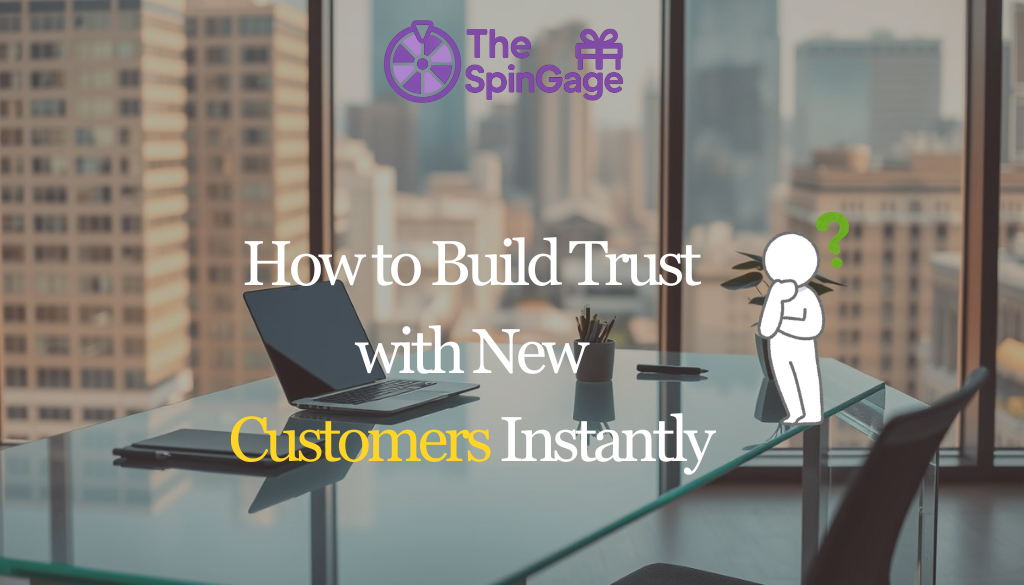


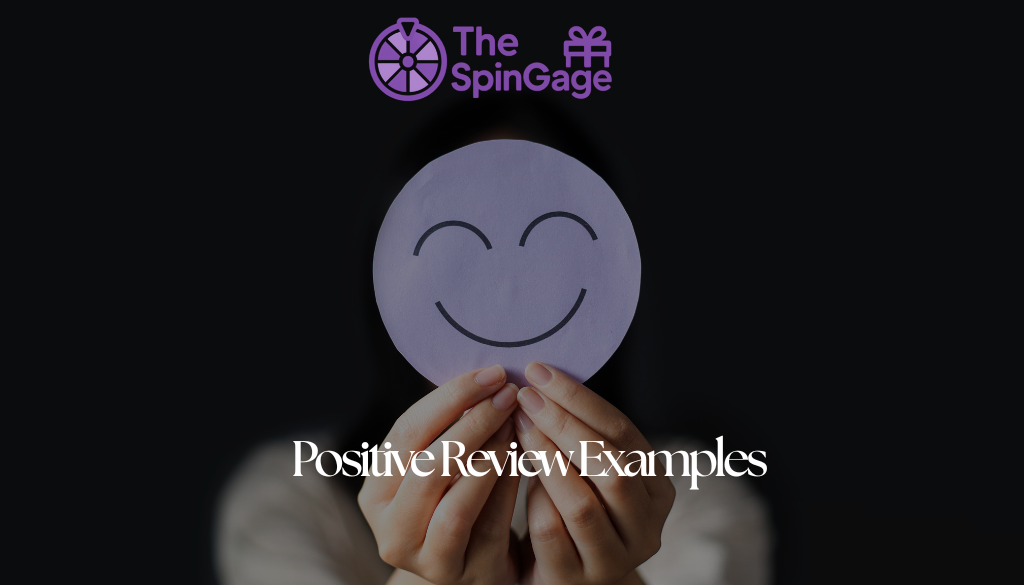





Leave a Reply